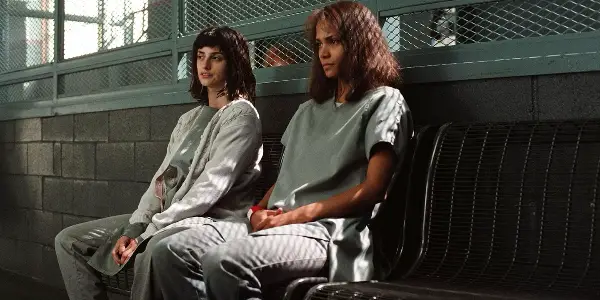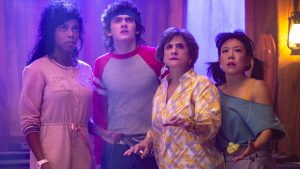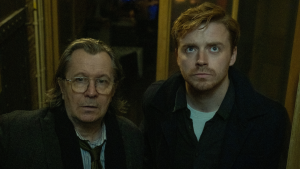
Welcome back to the scariest, and at times goriest, column here at Film Inquiry: Horrific Inquiry. Twice a month, I will be tackling all things horror, bringing two films back into the spotlight to terrify and frighten once more. And occasionally looking at those that could have pushed the envelope further. Join us as we dive deep into the heart of horror, but warning, there will be spoilers.
The 2000s was a big decade for me in developing my love for the horror genre, having grown old enough to start watching horror films on my own. And the possibilities were endless. Though as much as I would find some of my loves in the past films of Alfred Hitchcock and Wes Craven, many of my favorite horror films would came out of this time period, a sense of individuality and approaching adulthood quietly associated with each film I watched – for good or for bad. One film in particular marked a milestone in my independence, my freshman year of college kicking off with a dorm community watch of Mathieu Kassovitz‘s Gothika.
A big fan of Robert Zemeckis‘ What Lies Beneath, Gothika had a similar feel to it. It’s no surprise as Zemeckis was one of the film’s producers, yet Gothika still manages to retain its own identity and mystery. Recently, a click bait Facebook article image had me drawing back to the film, the years since my last viewing creating a craving to return. And with Robert Downey Jr‘s recent Oscar nomination, it felt even more appropriate that now should be the time to revisit the mystery and horror of Gothika.
Setting the Stage
Gothika is immediately eerie, the dark green, grey and black hues of the jail cell quickly filling audiences with ominous feelings of violence and danger. As the camera settles on two women, their relationship is immediately understood – doctor and patient. They contrast one another in both costume and dialogue, helping to craft the drastic change of circumstance for Dr. Miranda Grey (Halle Berry) later on in the film. As the camera alernates between the women, it keeps close, Chloe’s (Penélope Cruz) rape story sounding little more than the rantings and ravings of mad woman. This feeling of insanity is only further heightened as she describes how she killed her father and watched him die.
source: Warner Bros. Pictures
“You can’t trust someone when they think you are crazy?” It is the question that finds Dr. Grey ending her session with Chloe, the words lingering on a moment but carrying the weight of an entire film – even more so if you have seen Gothika before. The separation of patient and doctor is further driven through imagery as Chloe is taken away screaming by the guards, Dr Grey walking freely through the cells, giving little mind to the chaos ensuing behind her.
As Miranda makes her way through the remainder of her day we learn of her marriage to Dr. Douglas Grey (Charles S. Dutton), the head of the penitentiary, her flirtatious interactions with fellow colleague Pete Graham (Robert Downey Jr.), the buildings electrical issues, Miranda’s pension for swimming and her husband’s friendship with the local sheriff (John Carroll Lynch). The opening looses some its ominous tone as Miranda departs from Chloe, quietly driving further the separation between doctor and patient, while also introducing the film’s major players. Honestly, it is the classic horror tropes of flashing lights, failing generators and a treacherous rainstorm that keep the film’s horror on the horizon. Yet, as Miranda is diverted on her way home due to a sinkhole in the road, our trained eyes know everything is about change
source: Warner Bros Pictures
“Not Alone”
As the car crosses the bridge, a sudden appearance of a brutally injured woman (Kathleen Mackey) in the road causes Miranda to swerve into a tree. As she exits the vehicle and makes her way to the woman, Miranda and the audience take in together the abuse she has endured, uncontrollable shivering and emotional distress taking over the young woman. As Miranda attempts to ask he questions and give her a jacket for warmth, the woman grabs her face in a fit of rage, a fire bursting out and collapsing the film into darkness.
It is distorting, especially as the fire engulfs Miranda and the audience is plunged into darkness and silence. As Miranda wakes up in the penitentiary observation cell, there is a shared confusion with the audience as she comes to the understanding that she is on the other side – that she is now a patient. The film leans hard into these moments of contrast, making sure we understand how much things have changed for Miranda – how different it is on the other side. As Miranda is restrained, Pete enters appearing to make sure that Miranda understands that she is “Not Alone”. Sounding as though he is an advocate rather than just a doctor, Pete tries to help Miranda work through her repressed memory to see what is the last thing she remembers. And while Miranda works through the last things she can remember, the image of the woman on fire comes rushing back in a fury.
source: Warner Bros Pictures
“You are not a Doctor in here. And even if you tell the truth… no one will listen. You know why? Because you’re crazy. And the more you try to prove them wrong, the crazier you’ll appear. You are invisible now. Can you feel it?”
These words from Chloe later on care a heavy weight of truth. In an instant, the advocacy of Pete is diminished, denying that Miranda’s talk of a beaten woman on the road is her truth, rather revealing the truth he wants her to acknowledge, to remember – that she killed her husband. Consistently, Gothika will place Miranda in situations that find rationality in the irrational. Deemed a cutter after an incident in the bathroom, everyone is quick to accept Miranda’s growing insanity, caring little to search for the mysterious tool she used to cut herself with. No one wants to hear her story of the woman at the bridge, the existence of this story a delusional safeguard for the actions Mirana committed. No one wants to listen as Miranda witnesses the brutal beating of Chloe in isolation, the burning woman in chains tattoo on her assailants chest validating Chloes opening story, though only making Miranda seem crazier.
And while all this work to isolate Miranda appears effective from the medical standpoint, she is never truly alone. Miranda may not believe in ghosts, but as she says “they believe in me”. While Miranda and Chloe share a growing connection in the film, so does Miranda and the spirit haunting her. She is given little reprieve from the forceful spirit determined to meet its end game. While Miranda pushes back against the paranormal, reminding herself of her place as a doctor, she does not begin to unravel the truth until she starts to see things from a different perceptive – and accept that she is not alone.
source: Warner Bros Pictures
Conclusion
Gothika presents a unique multilayering in its continual use of the phrase “Not Alone”. It is discovered that Rachel is not the only victim to the killers Miranda uncovers. Additionally, it is discovered that a current victim held at Willow Creek was still alive, the seemingly vengeful spirit of Rachel leading Miranda to her discovery. The heaviest realization comes in the film’s penultimate moment, when Miranda realizing that “Not Alone” also means her husband was not the only killer. Sadly, the film feels anti-climatic in its closing scenes, the final moment of comeupance feeling rushed and unvengeful in the face of everything that has happened thus far. It doesn’t help either that the film’s visual effects setting the sheriff on fire have not aged well in the years since the film’s release.
While Gothika works within the construct of a haunting and possession film, there is a feministic approach between its lines elevating its continued interpretation and representation of “Not Alone”. Gothika is a film that quietly captures the inability of women to be believed – to be heard – primarily by men in power. And not just men, even women. In the beginning, Dr. Grey cannot look beyond the violence that Chloe represents to truly hear her story – to hear her cry for help. When the tables are turned, Pete responds similarly, unable to look beyond the perceived violence. Even the imagery of a women burning in flames is captured throughout the film, both in Rachel engulfed in flames as she possesses Miranda and in the dominance of the imagery closely associated with the violence of the sheriff on the women he beats and rapes. The only hope is in the unity of women, in the knowledge that they are not alone. As Chloe and Miranda grow closer, with Rachel pushing Miranda towards the truth, it is only by listening and unifying each of these women finds they are able to be heard and saved.
While Gothika may not have stood the test of time, or even present the most plausible horror narrative, it delivers an eerie watch that fans of the genre can enjoy. With its multilayered interpretation of the idea of not being alone, this simple horror film proves there is more than meets the eye.
Does content like this matter to you?
Become a Member and support film journalism. Unlock access to all of Film Inquiry`s great articles. Join a community of like-minded readers who are passionate about cinema – get access to our private members Network, give back to independent filmmakers, and more.




